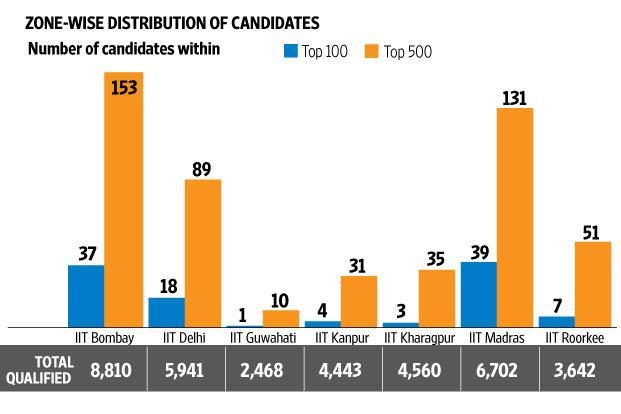 A file photo of the IIT Bombay campus. Of the total 36,566 rank holders, 31,996 were male and 4,570 were female. Photo: Mint
A file photo of the IIT Bombay campus. Of the total 36,566 rank holders, 31,996 were male and 4,570 were female. Photo: Mint
New Delhi: Indian Institutes of Technology, the country’s most prestigious engineering and technology schools, have announced the results of joint entrance examination—Advanced (JEE-Advanced), giving ranks to 36,566 candidates for seats in 22 IITs across India.
Of the total 36,566 rank holders, 31,996 were male and 4,570 were female.
Here are five charts explaining everything that you would like to know about JEE-Advanced from ranking criteria to male-female equation and seats availability in the IIT system.
Criteria for inclusion in JEE-Advanced Rank List
JEE-Advanced gauges the efficiency of a student in three subjects—Physics, Chemistry and Mathematics comprising six papers and 372 marks in total. The IITs prepared nine rank lists caste and reservation parameter wise including for general category, scheduled castes (SC), scheduled tribes (ST), other backward classes (OBC), persons with physical disability (PwD) and preparatory course rank list. The last one comprises those students who are mentored by IITs before some of them are enrolled in the course with a time-lag.
This year while a general category student was required to score a minimum of 75 marks of 372 for consideration to get a rank, it was 67 for an OBC aspirant and 38 for a SC or ST candidate.

Summary of candidates
After the JEE-Main exam, which works as a filter for JEE-Advanced, around 156,000 registered for the entrance of which 147,678 appeared for the test. Of these 36,566 were awarded ranks. JEE-Advanced data analysis shows that OBC aspirants (54,188) number were close to the number of general category students (59,758) who appeared for the entrance reflecting a growing trend of aspiration.

Foreign/OCI students
Of the total candidates qualified in JEE-Advanced, 71 were Overseas Citizens of India (OCI), People of Indian Origin (PIO) or foreign students.

Distribution of candidates by zone
IITs divide the country into seven zones for better monitoring of the JEE-Advanced and tabulation of data. IIT Bombay zone which includes places like Kota, the Rajasthan town known as the coaching capital of India, tops the list in terms of producing toppers and overall qualified students. IIT Bombay zone is followed by IIT Madras and IIT Delhi zone in the same parameters.

Number of seats available
IITs along with Indian schools of Mines Dhanbad in 2016 will admit 10,575 students at the B-Tech level based on the JEE-Advanced results. Of all the 23 institutes along with ISM, IIT Kharagpur admits the highest number of students (1,341), followed by IIT- BHU Varanasi (1,090) and IIT Roorkee (970).

 Techosta Where Tech Starts From
Techosta Where Tech Starts From